7 Chakras and Colors Explained: Complete Guide to Understanding Your Energy Centers

Hey there, beautiful soul! 🌟
I’m thrilled to have you here on this journey of exploring the incredible world of chakras!
What are chakras?
Think of your body as a vibrant energy river, with seven main energy centers—your chakras—guiding its flow.
These chakras influence every part of your life, from your physical health to your emotional well-being and spiritual growth. Together, we’ll unlock the secrets of these energy centers, learn how to balance them, and bring harmony into your life.
Ready to dive in? Let’s embark on this enlightening adventure together!
7 Chakras and Their Colors
Ever wondered about those vibrant colors associated with chakras? You’re in the right place. Let’s dive into the fascinating world of chakra colors, blending science, history, and a dash of personal stories.
Ready? Let’s go!
Picture this: ancient India, a serene temple surrounded by lush greenery. Here, wise sages and yogis first identified chakras as energy centers within the body. They described each chakra using colors, symbols and sounds, creating a system that would last for millennia.
1. Red Chakra: Muladhara or Root Chakra
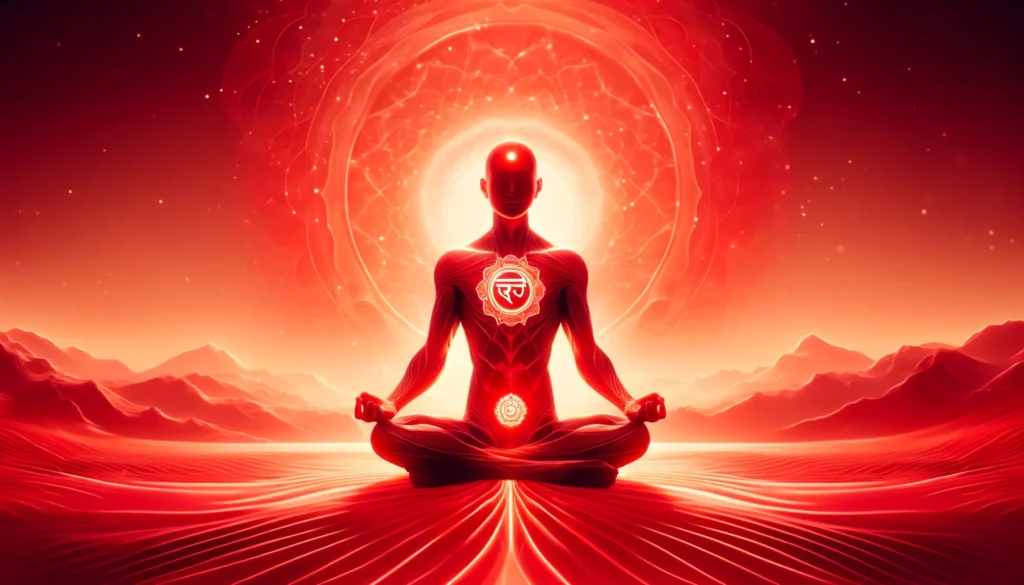
Let’s start at the very base of your spine. The Root Chakra, or Muladhara, is your foundation. Picture a deep red, like the rich soil that grounds a tree. This chakra is all about stability and security. When balanced, you feel safe and grounded. Think of it as your energetic anchor to the Earth. 🌍
Red is the color of life force and survival. It represents our connection to the physical world and provides the energy to tackle life’s challenges. When your Root Chakra is balanced, you feel confident and able to stand on your own two feet.
2. Orange Chakra: Svadhisthana or Sacral Chakra
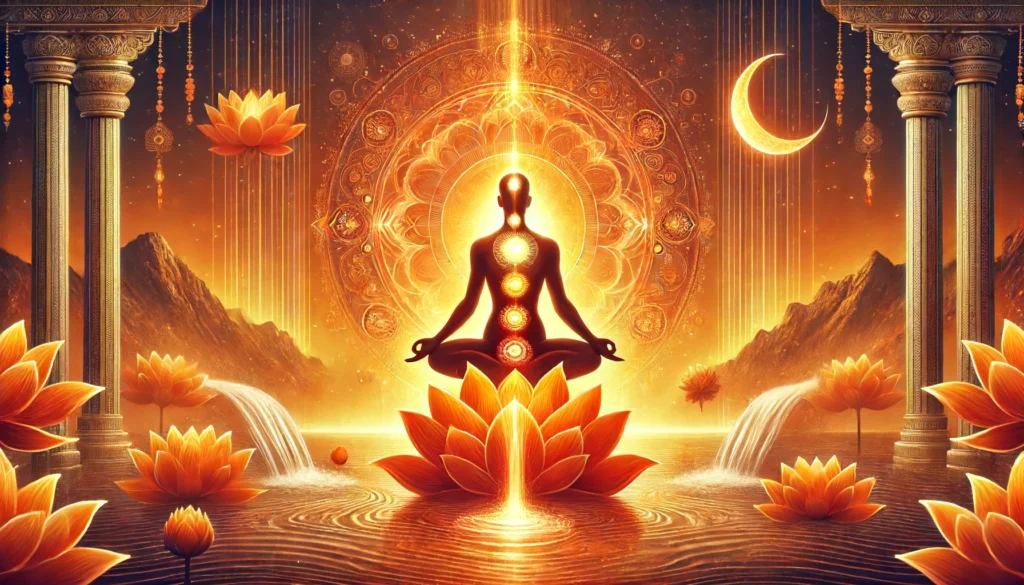
Moving up to the lower abdomen, we find the Sacral Chakra, or Svadhisthana. It radiates a warm orange glow, embodying creativity and passion. This is your center of pleasure and joy. When this chakra is in harmony, you feel vibrant and creative, flowing effortlessly through life like a river of ideas. 🌊 Orange represents enthusiasm, excitement, and vitality.
Orange is also the color of warmth and happiness. It encourages a healthy emotional state and inspires creativity. When your Sacral Chakra is balanced, you feel passionate, and your relationships and artistic endeavors flourish.
3. Yellow Chakra: Manipura or Solar Plexus Chakra
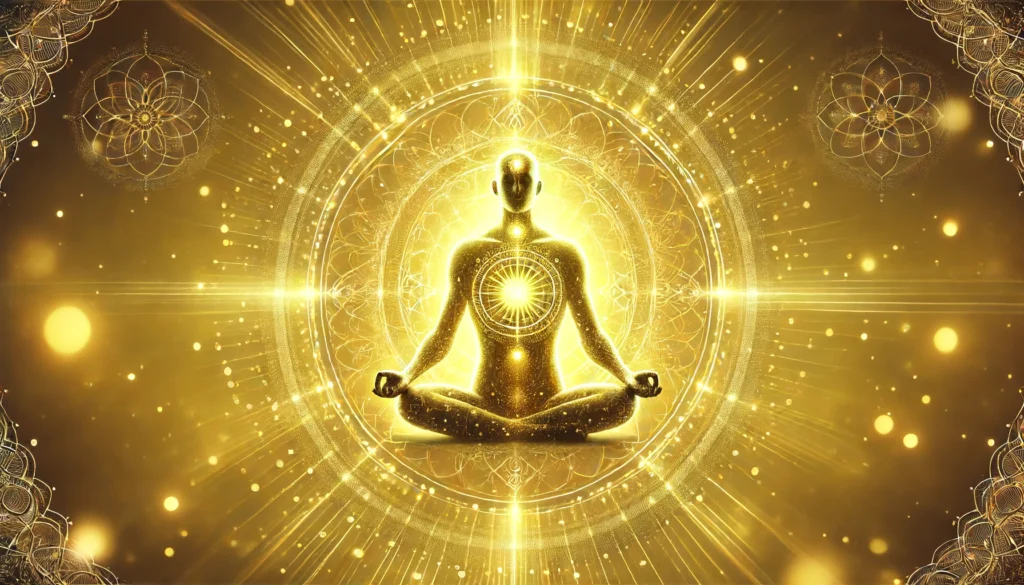
Next, we reach the Solar Plexus Chakra, or Manipura, located just above your navel. Visualize a bright, golden yellow. This chakra is your personal powerhouse, the seat of your confidence and willpower. A balanced Manipura makes you feel self-assured and determined, ready to take on the world with courage. ☀️ Yellow symbolizes energy, clarity, and intellect.
Yellow is the color of the sun and symbolizes your personal power and identity. It empowers you to follow your true path and stand out. When your Solar Plexus Chakra is in harmony, you radiate confidence and can achieve your goals with determination.
4. Green Chakra: Anahata or Heart Chakra

Ah, the Heart Chakra, or Anahata, right at the center of your chest. Imagine a lush, emerald green. This chakra is all about love, compassion, and connection. When your Heart Chakra is balanced, you radiate love and empathy, creating harmonious relationships with others and yourself. 💚 Green is the color of growth, harmony, and renewal.
Green symbolizes balance and renewal. It nurtures your capacity to love and heal. When your Heart Chakra is balanced, you experience deep connections with others and a profound sense of peace.
5. Blue Chakra: Vishuddha or Throat Chakra

Now, we move to the Throat Chakra, or Vishuddha, at the throat. Picture a clear, sky blue. This chakra governs your communication and expression. A balanced Throat Chakra allows you to speak your truth clearly and confidently, fostering honest and open interactions. 🌌 Blue represents trust, wisdom, and calm.
Blue is also the color of truth and serenity. It enhances your ability to communicate effectively and listen actively. When your Throat Chakra is in harmony, you can express yourself authentically and without fear.
6. Indigo Chakra: Ajna or Third Eye Chakra
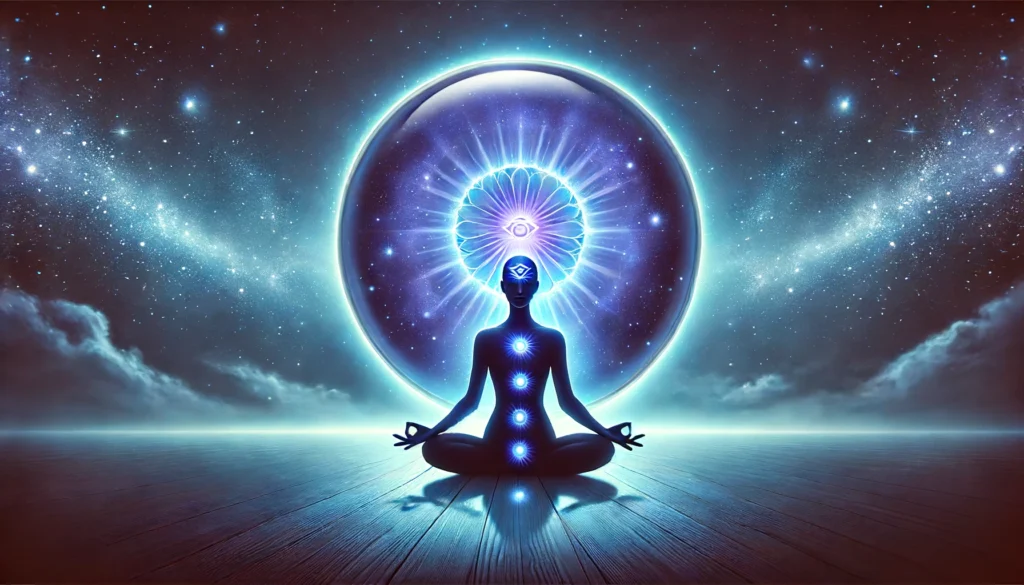
Ascending to the forehead, between your eyebrows, we find the Third Eye Chakra, or Ajna. Envision a deep indigo. This chakra is your intuition and inner wisdom. When Ajna is in harmony, you experience clarity and insight, seeing beyond the obvious and understanding deeper truths. 🌠 Indigo signifies perception, awareness, and intuition.
Indigo is the color of inner knowledge and spiritual awakening. It helps you access your intuition and see the bigger picture. When your Third Eye Chakra is balanced, you gain a deeper understanding of life’s mysteries.
7. Violet Chakra: Sahasrara or Crown Chakra
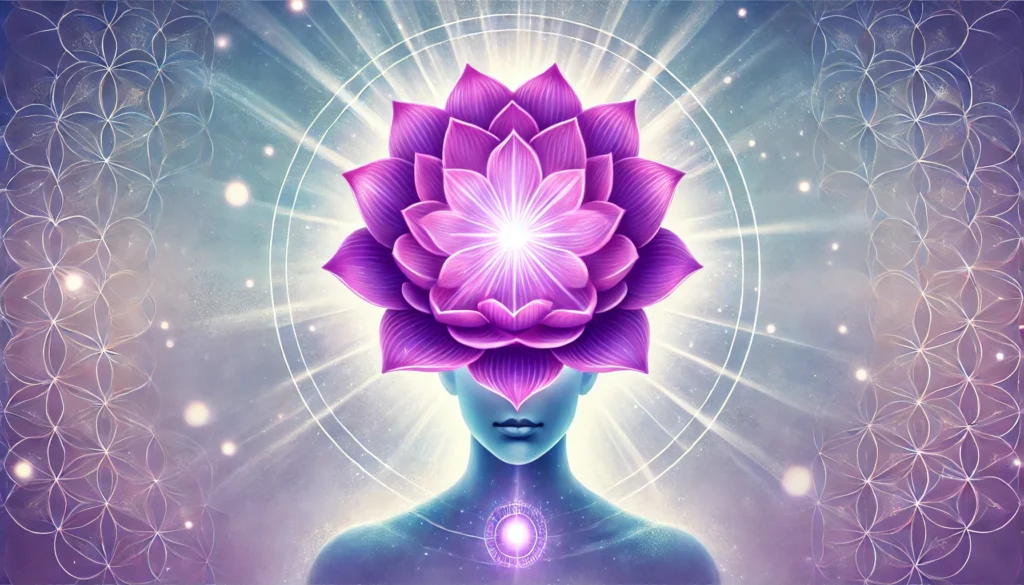
Finally, we reach the Crown Chakra, or Sahasrara, at the top of your head. Imagine a radiant violet or pure white light. This chakra connects you to the divine and the universe. A balanced Sahasrara brings a sense of unity and enlightenment, transcending the material world. 🌌 Violet represents spirituality, enlightenment, and connection to higher consciousness.
Violet is the color of spirituality and enlightenment. It opens you to higher states of consciousness and universal wisdom. When your Crown Chakra is in harmony, you feel connected to a higher power and experience profound spiritual insights.
The Science Behind the Chakra Colors
You might wonder, “Why these colors?” Great question!
Colors are more than just visual stimuli; they have frequencies and energies that can affect our mood and state of mind. According to chromotherapy, different colors can influence our physical and emotional well-being. Red, for example, is stimulating and energizing, while blue is calming and soothing (The Soul Connection) (Change Your Energy).
Once, during a particularly stressful time, I focused on my Heart Chakra. I visualized a radiant green light during my meditations. Slowly but surely, I felt a shift. My anxiety lessened, and I felt more at peace. It was a powerful experience, reaffirming the connection between colors and our inner state.
Historical Perspectives
The concept of chakras and their colors isn’t just an Eastern philosophy. Similar ideas appear in different cultures and traditions. For example, in ancient Egypt, colors were used for healing. They believed that each color had a specific power to restore balance in the body.
The Rosicrucians, a mystical European group, also explored the idea of energy centers and colors. They believed in a form of spiritual alchemy, where colors played a crucial role in transforming the soul.
Chakra colors aren’t just random; they’re deeply tied to our physical, emotional, and spiritual health. By understanding and working with these colors, we can enhance our well-being.
Next time you meditate, try focusing on the colors of the chakras. Visualize them, feel their energy, and notice any shifts within you.
Harmonizing Your Chakras:

Balancing these chakras is like tuning an instrument. Each one needs attention and care. Yoga, meditation, and mindful living can help align these energy centers, promoting overall well-being. 💫
Isn’t it fascinating how these colors and energies flow within us? By understanding and nurturing our chakras, we can live more balanced, joyful lives. So, dear seeker, keep exploring, meditating, and embracing the vibrant colors of your inner self.
Chakra Colors Infographic

Blocked Chakras
Chakras are like the energy hubs in our body. Imagine them as spinning wheels of energy, each corresponding to different parts of our physical and spiritual being. When these wheels spin freely, we feel vibrant, balanced, and in tune with ourselves and the world around us.
But what happens when they don’t?
Let’s Talk Chakra Blockage
Picture this: You’re driving a car. Suddenly, there’s a traffic jam.
No matter how much you want to move forward, you’re stuck. Similarly, when a chakra is blocked, energy can’t flow freely, and you might feel stuck in your life.
For instance, when I first started my yoga journey, I constantly felt anxious and overwhelmed. I couldn’t figure out why until my mentor pointed out that my root chakra – the one that keeps us grounded – was blocked. It was like trying to build a house on a shaky foundation. No wonder I felt unsettled!
Blocked chakras can manifest in various ways. An overactive solar plexus chakra might make you feel overly aggressive or domineering, while an underactive heart chakra might leave you feeling lonely and disconnected. Recognizing these signs is the first step towards healing.
Unblocking Your Chakras: The Path to Healing
Ready to get those wheels spinning again?
One of the simplest ways to unblock your chakras is through meditation. Imagine sitting in a quiet place, focusing on your breath. With each inhale, you draw in positive energy; with each exhale, you release tension and negativity. I remember a time when my throat chakra was blocked – I couldn’t express myself clearly, felt misunderstood. Guided meditation focusing on a blue light at my throat helped me regain my voice. It was magical!
Yoga poses are also powerful tools. For instance, to open your heart chakra, try backbends like Camel Pose or Wheel Pose. These poses stretch your chest and help release pent-up emotions.
Oh, and don’t underestimate the power of sound! Chanting mantras can resonate with your chakras. The mantra “Lam” resonates with the root chakra, helping to stabilize and ground you.
Healing Chakras with Nature’s Gifts
Nature offers us incredible gifts for chakra healing too. Crystals like amethyst can soothe the crown chakra, promoting spiritual growth and peace. I keep a rose quartz near me when meditating to open my heart chakra and invite love into my life. Essential oils are another favorite of mine – lavender for calming the third eye chakra, sandalwood for grounding the root.
Eating a balanced diet can also play a crucial role. Foods resonate with different chakras. Root vegetables like carrots and potatoes ground you and nourish the root chakra, while leafy greens energize the heart chakra.
Balancing and Aligning Your Chakras: Keeping the Harmony
Once you’ve unblocked your chakras, maintaining balance is key. Think of it as tending a garden – regular care and attention keep everything flourishing.
Incorporate daily practices to keep your energy flowing smoothly. Start your day with a quick chakra meditation. Visualize each chakra glowing brightly as you breathe deeply. Practicing gratitude can also align your heart chakra. Before bed, reflect on what you’re thankful for. This simple practice has brought immense joy and balance to my life.
Yoga, of course, remains a cornerstone. Poses like Tree Pose and Mountain Pose ground you, aligning your chakras from the base of your spine to the crown of your head. I often share this with my students: “When in doubt, root down to rise up.” It’s a reminder that grounding yourself helps you reach new heights.
The Science Behind It All
You might wonder, is there any science to back this up?
Actually, yes! Research has shown that practices like meditation and yoga can significantly reduce stress, enhance well-being, and even improve brain function (Harvard Health Publishing, 2020)*. While chakras themselves are rooted in spiritual traditions, the benefits of aligning your energy centers align beautifully with what science tells us about the mind-body connection.
Harvard Health Publishing. (2020). The real-world benefits of meditation. Retrieved from Harvard Health.
Your Journey Ahead
So, my friend, are you ready to embark on this journey of chakra healing and alignment? Remember, it’s not about being perfect. It’s about being present, listening to your body, and nurturing your spirit.
Take it one step at a time. Start with a simple meditation or try a new yoga pose. Notice how you feel. Keep a journal of your experiences. This journey is deeply personal, and your path will be unique.
Chakra Healing and Balancing Techniques:
So, you’ve started exploring the incredible world of chakras and now you’re eager to dive deeper into balancing and healing these powerful energy centers. Fantastic! Today, I’m thrilled to share with you some of my favorite techniques that have transformed not only my life but also the lives of many of my students. From yoga and meditation to mantras and crystals, we’ve got a treasure trove of practices to explore.
Ready to embark on this enlightening journey? Let’s go!
The Power of Yoga for Chakra Balancing
Yoga isn’t just about flexibility or physical strength. It’s a beautiful dance between the body, mind, and spirit, helping us to align and balance our chakras. Different poses (or asanas) target specific chakras, unblocking stagnant energy and restoring harmony.
For instance:
- Root Chakra (Muladhara): Try Tree Pose (Vrikshasana). Stand tall, rooting down through your feet, grounding your energy. Imagine yourself as a tree with deep roots, stable and secure.
- Sacral Chakra (Svadhisthana): Hip-openers like Bound Angle Pose (Baddha Konasana) are fantastic. Sit with the soles of your feet together and gently press your knees towards the floor. This pose helps release creativity and passion.
- Solar Plexus Chakra (Manipura): Boat Pose (Navasana) is perfect for this. Sit on the floor, lift your legs, and balance on your sit bones. This pose ignites your inner fire and boosts confidence.
- Heart Chakra (Anahata): Camel Pose (Ustrasana) is my go-to. Kneel and arch your back, reaching for your heels. This heart-opener is all about love and compassion.
- Throat Chakra (Vishuddha): Fish Pose (Matsyasana) works wonders. Lie on your back, lift your chest, and rest on the crown of your head. It opens your throat, promoting clear communication.
- Third Eye Chakra (Ajna): Child’s Pose (Balasana) helps. Kneel and fold forward, resting your forehead on the ground. It’s calming and enhances intuition.
- Crown Chakra (Sahasrara): Headstand (Sirsasana) can be powerful, but if that’s too advanced, simply sit in meditation. This pose connects you to higher consciousness.
Remember, yoga is a practice, not a perfect. Listen to your body and do what feels right for you.
Meditation: A Gateway to Inner Peace
Meditation is a cornerstone of chakra healing. It’s like giving your chakras a soothing massage, helping them to spin freely and radiate energy.
Here’s a simple chakra meditation to get you started:
- Find a quiet space and sit comfortably. Close your eyes and take a few deep breaths.
- Visualize a glowing ball of red light at the base of your spine. This is your root chakra. Breathe in and imagine this light growing brighter.
- Move upwards, visualizing an orange light in your lower abdomen (sacral chakra), a yellow light in your solar plexus, a green light in your heart, a blue light in your throat, an indigo light between your eyebrows (third eye), and finally, a violet light at the top of your head (crown chakra).
- Spend a few minutes with each chakra, visualizing the light growing and spinning freely.
- Finish by visualizing a white light surrounding your entire body, protecting and harmonizing your energy.
Mantras: The Sound of Healing
Mantras are sacred sounds or phrases that resonate with specific chakras, helping to balance and heal them. Chanting these mantras can be incredibly powerful.
Here are some mantras for each chakra:
- Root Chakra: “Lam”
- Sacral Chakra: “Vam”
- Solar Plexus Chakra: “Ram”
- Heart Chakra: “Yam”
- Throat Chakra: “Ham”
- Third Eye Chakra: “Om”
- Crown Chakra: Silence (simply sitting in meditation)
Try chanting these mantras during meditation or even silently throughout your day. Notice how the vibrations shift your energy.
Stones and Crystals: Nature’s Healing Treasures
Crystals have been used for centuries to heal and balance chakras. Each type of crystal resonates with a specific chakra, helping to restore its natural energy flow.
- Root Chakra: Red jasper, hematite
- Sacral Chakra: Carnelian, orange calcite
- Solar Plexus Chakra: Citrine, tiger’s eye
- Heart Chakra: Rose quartz, green aventurine
- Throat Chakra: Blue lace agate, turquoise
- Third Eye Chakra: Amethyst, lapis lazuli
- Crown Chakra: Clear quartz, selenite
Carry these crystals with you, place them on your body during meditation, or keep them in your living space. Their energy can be a gentle yet powerful aid in your chakra balancing journey.
Other Techniques to Explore
- Aromatherapy: Essential oils like lavender, sandalwood, and peppermint can balance your chakras. Diffuse them, add them to your bath, or use them in a massage.
- Reiki: This healing technique involves a practitioner channeling energy into your body to balance your chakras. It’s a deeply relaxing and restorative experience.
- Sound Healing: Instruments like singing bowls, tuning forks, and gongs produce frequencies that can align your chakras. Attend a sound bath session or try using these instruments yourself.
Your Path to Harmony
Balancing and healing your chakras is a journey, not a destination. It’s about exploring, discovering what resonates with you, and incorporating these practices into your daily life.
Start with what feels right. Maybe it’s a simple yoga pose or a few minutes of chanting. Gradually, you’ll find a rhythm that works for you. And remember, I’m here with you every step of the way. Feel free to share your experiences, ask questions, or just say hi.
Exploring Beyond the Seven: A Journey Through Other Chakra Systems
Ready to expand your horizons?
The Twelve-Chakra System: Reaching New Heights
While the seven-chakra system is most commonly known, the twelve-chakra system adds layers of depth and connection to higher realms. This system includes the traditional seven chakras and introduces five additional ones, extending beyond the physical body.
Here’s a quick overview:
- Earth Star Chakra: Located about 12 inches below the feet, this chakra connects us to the Earth’s energy, grounding and stabilizing our entire system.
- Root Chakra (Muladhara)
- Sacral Chakra (Svadhisthana)
- Solar Plexus Chakra (Manipura)
- Heart Chakra (Anahata)
- Throat Chakra (Vishuddha)
- Third Eye Chakra (Ajna)
- Crown Chakra (Sahasrara)
- Soul Star Chakra: Positioned about 6 inches above the crown, this chakra is linked to our higher self and soul’s purpose.
- Stellar Gateway Chakra: Even higher above, this chakra connects us to the divine and universal energies.
- Universal Chakra: This chakra integrates cosmic consciousness and the universal mind.
- Divine Gateway Chakra: The highest chakra in this system, connecting us to the source of all creation, pure divine energy.
Imagine a beautiful column of light extending from the Earth Star Chakra, through your body, and up to the Divine Gateway Chakra. This system emphasizes our connection to both the Earth and the cosmos, enhancing spiritual growth and higher consciousness.
The Magic of Symbols: Visual Guides for Your Chakras
Symbols have been used throughout history to convey deep spiritual truths and energies. Each chakra has its own unique symbol, often depicted as a lotus flower with a specific number of petals and a geometric shape inside.
Let’s take a closer look at each chakra symbol:
- Root Chakra (Muladhara): A four-petaled lotus with a square and a downward-pointing triangle inside. This symbol represents stability, foundation, and grounding.
- Sacral Chakra (Svadhisthana): A six-petaled lotus with a crescent moon. It embodies creativity, pleasure, and emotional balance.
- Solar Plexus Chakra (Manipura): A ten-petaled lotus with an inverted triangle. This symbol is all about power, self-esteem, and transformation.
- Heart Chakra (Anahata): A twelve-petaled lotus with two intersecting triangles forming a six-pointed star. It symbolizes love, compassion, and balance.
- Throat Chakra (Vishuddha): A sixteen-petaled lotus with a circle containing a downward-pointing triangle. This represents communication, expression, and truth.
- Third Eye Chakra (Ajna): A two-petaled lotus with a circle and an inverted triangle. It signifies intuition, insight, and spiritual awareness.
- Crown Chakra (Sahasrara): A thousand-petaled lotus symbolizing pure consciousness and connection to the divine.
Using these symbols in your meditation and daily practice can help you focus on the specific energies of each chakra. You can draw them, visualize them, or place them in your sacred space.
The Power of Yantras: Geometric Pathways to the Divine
Yantras are mystical diagrams used in Indian spiritual traditions, often associated with specific deities and energies. They are considered powerful tools for meditation, helping to focus the mind and connect with higher states of consciousness.
Each chakra has its own yantra, amplifying its unique energy. Here’s how you can use them:
- Root Chakra Yantra: This yantra features a square with four gates, symbolizing the element of earth. Meditating on this yantra can help you feel more grounded and secure.
- Sacral Chakra Yantra: This yantra includes a crescent moon, representing the water element and the flow of emotions. It aids in enhancing creativity and emotional balance.
- Solar Plexus Chakra Yantra: Featuring an inverted triangle within a circle, this yantra symbolizes fire and transformation. It can boost your confidence and personal power.
- Heart Chakra Yantra: This yantra combines two intersecting triangles, symbolizing the air element and balance. It fosters love and compassion.
- Throat Chakra Yantra: A circle within a downward-pointing triangle represents ether, aiding in clear communication and self-expression.
- Third Eye Chakra Yantra: This yantra consists of a circle and an inverted triangle, symbolizing light and intuition. It enhances spiritual insight and clarity.
- Crown Chakra Yantra: This yantra is a thousand-petaled lotus, representing unity with the divine. Meditating on it can elevate your spiritual consciousness.
Practical Tips for Using Symbols and Yantras
Incorporating symbols and yantras into your chakra work can be a transformative experience. Here are some practical ways to use them:
- Meditation: Focus on a specific chakra symbol or yantra during meditation. Visualize it glowing and spinning, drawing in positive energy and dispelling negativity.
- Art and Creativity: Draw or paint chakra symbols and yantras. The creative process itself can be healing and meditative.
- Sacred Space: Place symbols and yantras in your meditation space, altar, or even as a screensaver on your phone. They serve as constant reminders of your spiritual journey.
- Visualization: Before sleep or during quiet moments, visualize the symbols and yantras of the chakras you wish to balance. Imagine their energies harmonizing and aligning your entire being.
- Journaling: Write about your experiences with each chakra symbol and yantra. Reflect on how they affect your energy and emotions.
The Science Behind Symbols
You might wonder, what’s the science behind all this?
Symbols and geometric shapes have a profound effect on our subconscious mind. They can influence our thoughts, emotions, and energy patterns. According to Carl Jung, symbols carry meanings that resonate deeply within our psyche, often beyond our conscious understanding (Jung, 1964).
Studies have also shown that focusing on geometric shapes and patterns can induce a meditative state, reducing stress and enhancing overall well-being (Kokoszka, 2007).
Your Journey with Symbols and Yantras
Exploring symbols and yantras opens a gateway to deeper self-awareness and spiritual growth. These ancient tools, rich with meaning and power, can enhance your chakra practice in ways you might not have imagined.
Start by choosing one symbol or yantra that resonates with you. Spend a few minutes each day focusing on it, whether through meditation, drawing, or simple visualization. Notice how it shifts your energy and perception.
As always, I’m here to support you on this journey. Share your experiences, ask questions, or just connect. We’re in this together, unlocking the mysteries of our inner world.
Sources:
- Harvard Health Publishing. (2020). The real-world benefits of meditation. Retrieved from Harvard Health.
- Mayo Clinic Staff. (2018). Yoga: What You Need To Know. Retrieved from Mayo Clinic.
- American Psychological Association. (2019). The healing power of Reiki. Retrieved from APA.
- Harvey, A. (2019). The Direct Path: Creating a Personal Journey to the Divine Using the World’s Spiritual Traditions. New World Library.
- Judith, A. (2004). Wheels of Life: A User’s Guide to the Chakra System. Llewellyn Publications.
- Sivananda Yoga Vedanta Center. (2009). The Chakra Bible: The Definitive Guide to Working with Chakras. Sterling Publishing.